| Nara This is the oldest Japanese hydrant we know of. It is located in front of the historic Nara National Museum. The Museum itself was built in 1895, but information about the date of the hydrant is unknown. The ball atop the bonnet may have been for tying horses. | 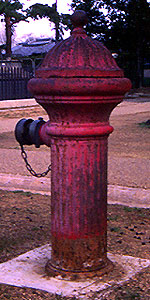 |
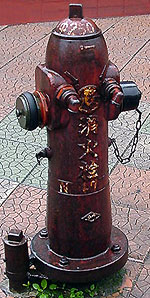 | Nagahama The vintage and manufacturer of this hydrant are unknown, but it conforms to the current Japanese practice of specifying two 65mm hose outlets which both have independent valves. The plugged pipe at the bottom left may be to pump out the hydrant after use. A similar scheme was used on Hamar hydrants made in Iceland. Photo © 2001 Takehiro Adachi |
| Tokyo Here is a current model fire hydrant manufactured in Tokyo by Yokoi Mfg, Ltd. Photo © 2001, Yokoi Mfg Ltd. | 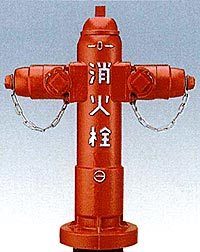 |
| Tokyo Another modern specification Japanese hydrant, this one manufactured by Maezawa Industries, also of Tokyo. Photo © 2001 Colin Maseca |
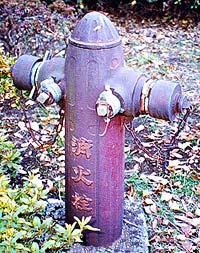 |
 | Hakodate, Hokkaido After a large fire in Hakodate City in 1934, it was decided that the water infrastructure needed to be modernized, including the hydrants. Until this point, hydrants were of the below ground type, meaning that they were buried during heavy snowfall, and difficult to find during a fire emergency. Someone from the city traveled to the U.S.A. to survey the fire hydrant systems there and the unique hydrant at left is the result. It's outward appearance may have been based on the Race & Mathews design manufacturered by R.D. Wood Co. of Philadelphia, Pennsylvania, USA. |
Otaru (right) Snow Hydrant? Matsudai, Niigata prefecture (far right) Deep Snow Hydrant. This design by Kitagawa Iron Works overcomes deep snow by standing more than 6½ feet tall. The hydrant has two operating nuts. The nut about half way up is for normal operation, while the second nut atop the hydrant is available during heavy snowfall when much of the barrel of the hydrant is buried. Photo © 2001 Amparo Bertram |
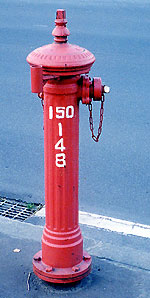 |  |

| Tokyo A contact at Sakura-Rubber, a manufacturer whose product line includes fire hose, had offered to send us some hydrant photos from Tokyo. As he discovered, most of the hydrants in his area of the city are either below ground or wall mounted. Shown here is a detail from the locked cover of a below ground hydrant on the streets of Tokyo. |
|
Unless otherwise noted, all contents of these WWW pages © 1996-2002, Ethan Kennedy |